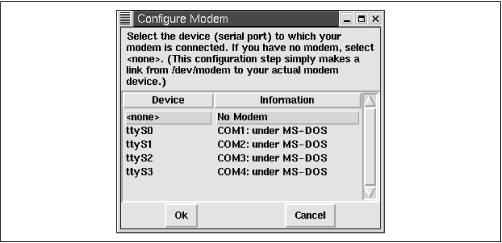Configuring Your Modem
Your modem is a peripheral device to Linux, like a CD-ROM drive, hard drive, or a mouse. Your modem will be connected to a serial port, which means that one of the serial devices in the /dev directory actually points to your modem. You’ll notice that there’s also a file, /dev/modem, which serves as a placeholder for your modem. Initially this file doesn’t point to anything. To simplify your operations, so that applications like minicom and seyon need only refer to /dev/modem, you can create a symbolic link from the serial device connected to your modem to /dev/modem. The easiest way to do so is to use modemtool.
To use modemtool, start X. Then launch an xterm and issue the following commands:
su export DISPLAY=:0 modemtool
You’ll have to correctly respond to su’s request for the root password.
Figure 11.1 shows the dialog box that modemtool displays. Simply click on the device that corresponds to your modem (usually ttyS1) and click on Ok. The program creates the required symbolic link on your behalf.

Figure 11-1. Using modemtool to configure a modem
Alternatively, from the console or an xterm, you can issue the command:
ln -s /dev/ttySX /dev/modemwhere X is replaced by the number corresponding to the serial device that points to your modem.
Tip
Conventions about numbering devices differ on different systems. On Windows, device numbers begin with 1, so your ...
Get Learning Red Hat Linux now with the O’Reilly learning platform.
O’Reilly members experience books, live events, courses curated by job role, and more from O’Reilly and nearly 200 top publishers.

